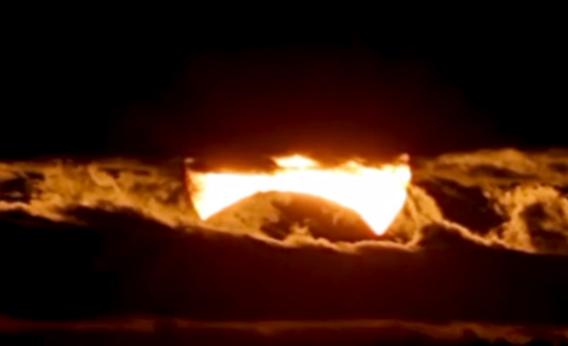Create a free profile to get unlimited access to exclusive videos, sweepstakes, and more!
A Solar Eclipse, From Heaven and Earth

On Sunday morning, observers on Earth saw the Moon slip between them and the Sun, causing a solar eclipse.
Well, some observers on Earth. The timing was such that folks on the U.S. East Coast saw the eclipse already in progress when the Sun (and Moon) roseâit was only a partial eclipse for them anyway. People farther east, like in Europe and Africa, saw a total eclipse during midday or late afternoon. From space, âdayâ and ânightâ are a matter of some subjectivity, but the eclipse was visible from there, too.
And from all these locations shutters were snapping away, creating lovely images and video of the event. First up, Iâd like to show you a partially eclipsed sunrise, care of Steve Ellington, who viewed it from the U.S. East Coast:
Thatâs spectacular. Iâve seen quite a few partial eclipses but never like that!
And I love this: The eclipse was even seen from space. The Russian weather satellite Elektro-L took a series of images that journalist Vitaliy Egorov turned into a cool animation.
This may need a bit of explaining. Elektro-L looks down over Russia (actually, itâs centered south of India, over the equator, but it sees all of Russia from there), so Africa is near the Earthâs western edge. The satellite is in a 24-hour orbit, so it seems as if itâs hovering over one spot on the Earth; conversely, from the satelliteâs point of view, the Earth seems fixed beneath it. However, as the Earth rotates, the shadow line (called the terminator) between day and night sweeps across the Earthâs face, moving east to west.
Over Africa, the eclipse happened near sunset. You can see the crescent Earth, with the terminator moving to the left (west). Suddenly, the Moonâs shadow appears as an oval on the extreme left, moving to the right (due to the Moonâs motion around the Earth as well as the Earthâs rotation). Itâs only there for a moment in the video, but itâs still fascinating: The complex motions of the Earth, Moon, and satellite all combine into a lovely dance played out over hours and across continents ⦠and space.
More pictures of this eclipse have been posted on UniverseToday.com.
And I have to add: Every time thereâs an eclipse, people start posting fake pictures on social media. Itâs as predictable as, well, eclipses. This one made the rounds on Sunday:
The claim is it was the eclipse seen from the International Space Station, and it was reposted by many, many people. Iâm not surprised, it does look real, but it is in fact a piece of art! It was created in 2009 by Ryuunosuke Takeshige, aka A4size-ska, and is posted on Deviantart. If you see someone posting it on Twitter or somewhere else claiming itâs real, point them to this article I wrote in 2012 showing itâs not. If you want to know what an eclipse looks like from the ISS, then try this instead. Itâs real.
The next solar eclipse wonât be visible until April 29, 2014, and will only be seen from Australia and parts of Indonesia. After that, thereâs another one on Oct. 23, 2014, thatâs visible from Canada and the U.S., but itâs only a partial one. Still, theyâre fun to watch. Iâll have more info about those eclipses closer to the time. But just to be sure, you should probably order your eclipse glasses now!


























